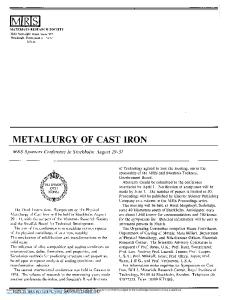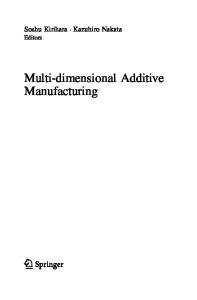Laser Processing of Cast Iron for Enhanced Erosion Resistance
- PDF / 3,298,557 Bytes
- 10 Pages / 594 x 774 pts Page_size
- 39 Downloads / 337 Views
I.
INTRODUCTION
C A S T irons frequently are used because of their low cost and desirable properties--low melting point, good fluidity and castability, excellent machinability, good wear resistance, and good mechanical properties. However, under severe service conditions their performance and reliability can be limited by various forms of wear, including erosion. One way of minimizing these troubles is to use more highly alloyed materials which combine superior wear resistance with adequate toughness. This solution to the problem is achieved only by increased consumption of critical alloying elements and increased material cost. Generally, manufacturing procedures for these highly alloyed cast irons also become more exacting and costly. A cost effective alternative to the bulk alloying approach is to modify the surface microstructure to improve wear resistance. Directed energy sources such as laser and electron beams are ideally suited for this type of surface modification. As an example of such surface modification, in a recent study by Ayres et al.,~ composite-like surfaces with potentially excellent wear characteristics have been produced by injecting hard TiC and WC particles into a laser generated melt zone. The CO2 laser is a versatile surface hardening tool since it allows precise spatial and temporal control of the energy delivered to a surface. These characteristics allow surface processing to be done rapidly with minimal distortion and no need for a quenchant. This type of laser surface hardening treatment has found wide commercial acceptance .2 The laser also allows treatment of hardto-reach places and treatment in only those places where it is needed. It is likely that in many instances a controlled surface hardening technique, such as laser processing, will provide a better alternative than either alloying or throughhardening as far as wear resistance and total cost are concerned. Reviews of laser processing beyond the scope of this paper may be found in References 3 through 6. In general, previous research into laser processing of cast iron can be classified into three categories: transformation C.H. CHEN, Graduate Research Assistant, C.J. ALTSTETTER, Professor, and J. M. RIGSBEE, Assistant Professor, are with the Department of Metallurgy and Mining Engineering, 1304 West Green Street, University of Illinois at Urbana-Champaign, Urbana, IL 61801. Manuscript submitted June 29, 1983. METALLURGICALTRANSACTIONS A
hardening,7'8'9 hardening with surface melting, 1~ and rapid solidification with formation of an amorphous phase) 6 The laser transformation hardening process typically produces a martensitic matrix, containing flake or nodular graphite, with a measured hardness value of 600 to 700 HV. 7'8'9 Hardening with surface melting usually produces a mixed microstructure of retained austenite, cementite, and martensite. Depending on the starting materials and processing parameters, the hardnesses vary considerably. As found in References 10 through 15, the hardnesses of the austenite range from 500 to 7
Data Loading...











